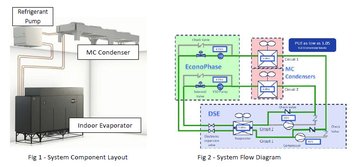Building regulators in drought-hit California have approved the use of cooling technology which uses chemical refrigerant instead of water, in response to a request from Emerson Network Power.
Until now, California’s relatively strict Building Energy Efficiency Standards (Title 24) have forbidden the use of refrigerant in so-called “economizer” cooling systems, mandating either the use of outside air (air-side economizers) or a water circuit (water-side economizers). In May 2015, Emerson proposed a change in the rules to allow the use of refrigerants in data center economizers, and this has now been approved.
Overcoming objections
In light of the severe drought conditions currently being experienced in California, it is not surprising that the regulators approved a technology that replaces water in the cooling cycle and promises potentially greater efficiency. However, the state had to overcome its wish to limit the commercial use of potential polllutants such as chemical refrigerants.
The pumped refrigerant economizer technology that Emerson proposed for approval (the Leibert DSE cooling system) uses a method very similar to that of water based economizers. It makes use of outside air until a threshold criteria is met, at which point the air compressors are turned off and the refrigerant pump is brought online. The three components of the system, a CRAC, air cooled condenser, and refrigerant pump, behave like a standard compressorized cooling system, and the same evaporator and condenser coil circuit is used regardless of whether air or refrigerant is providing the cooling.
The system is completely dynamic, tailoring the cooling provided to the workload in the data center, allowing it to use air cooling at temperatures higher than might traditionally be used with a fixed threshold system. This dynamic operational capability goes a long way to reducing the operational cost of the pumped refrigerant system below that of a traditional water based chiller.
The state’s Title 24 document has been very specific in how data centers should be cooled, but Emerson was able to provide testing results that showed that its pumped refrigerant system would meet or exceed the requirements of the standard in 14 of the 16 climate areas that were defined by the requirements (available here, along with the proposed changes to Title 24).
Would the technology have been approved if drought conditions had not impacted water availability in the state so severely? We will never know, but for now, the Emerson refrigerant-based cooling system can be used in California.

